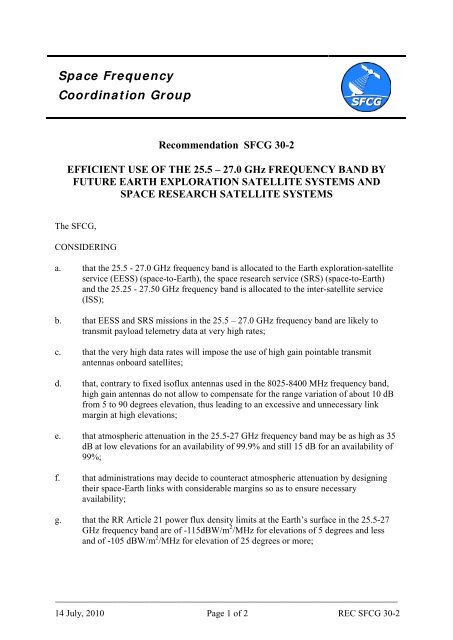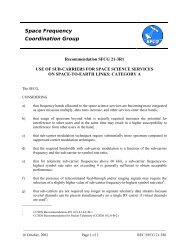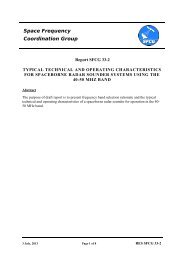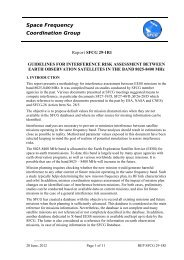Space Frequency - SFCG
Space Frequency - SFCG
Space Frequency - SFCG
Create successful ePaper yourself
Turn your PDF publications into a flip-book with our unique Google optimized e-Paper software.
<strong>Space</strong> <strong>Frequency</strong><br />
Coordination Group<br />
Recommendation <strong>SFCG</strong> 30-2<br />
EFFICIENT USE OF THE 25.5 – 27.0 GHz FREQUENCY BAND BY<br />
FUTURE EARTH EXPLORATION SATELLITE SYSTEMS AND<br />
SPACE RESEARCH SATELLITE SYSTEMS<br />
The <strong>SFCG</strong>,<br />
CONSIDERING<br />
a. that the 25.5 - 27.0 GHz frequency band is allocated to the Earth exploration-satellite<br />
service (EESS) (space-to-Earth), the space research service (SRS) (space-to-Earth)<br />
and the 25.25 - 27.50 GHz frequency band is allocated to the inter-satellite service<br />
(ISS);<br />
b. that EESS and SRS missions in the 25.5 – 27.0 GHz frequency band are likely to<br />
transmit payload telemetry data at very high rates;<br />
c. that the very high data rates will impose the use of high gain pointable transmit<br />
antennas onboard satellites;<br />
d. that, contrary to fixed isoflux antennas used in the 8025-8400 MHz frequency band,<br />
high gain antennas do not allow to compensate for the range variation of about 10 dB<br />
from 5 to 90 degrees elevation, thus leading to an excessive and unnecessary link<br />
margin at high elevations;<br />
e. that atmospheric attenuation in the 25.5-27 GHz frequency band may be as high as 35<br />
dB at low elevations for an availability of 99.9% and still 15 dB for an availability of<br />
99%;<br />
f. that administrations may decide to counteract atmospheric attenuation by designing<br />
their space-Earth links with considerable margins so as to ensure necessary<br />
availability;<br />
g. that the RR Article 21 power flux density limits at the Earth’s surface in the 25.5-27<br />
GHz frequency band are of -115dBW/m 2 /MHz for elevations of 5 degrees and less<br />
and of -105 dBW/m 2 /MHz for elevation of 25 degrees or more;<br />
___________________________________________________________________________<br />
14 July, 2010 Page 1 of 2 REC <strong>SFCG</strong> 30-2
h. that manned missions may have different operational constraints than unmanned<br />
missions that may preclude the implementation of certain advanced operational<br />
techniques,<br />
FURTHER CONSIDERING<br />
i. that operational adjustment of the transmit power along a pass is costly, inefficient<br />
and may affect the reliability of the onboard high power amplifier;<br />
j. that variable coding and modulation (VCM) techniques exist and are used<br />
operationally for space-Earth links of telecommunication satellites;<br />
k. that VCM techniques can be used to compensate for range variations, variations of<br />
atmospheric attenuation or both;<br />
l. that already with simple coarse range compensation using VCM, a data throughput<br />
increase of typically 90% or a bandwidth reduction by a factor of typically 1.6 can be<br />
obtained while finer and more performing range compensation will be feasible in<br />
most cases;<br />
m. that adaptive coding and modulation (ACM) would allow even more efficient use of<br />
the link through real-time compensation of atmospheric attenuation;<br />
n. that higher elevation angle tracking techniques, in which transmissions begin at<br />
relatively large elevations angles (e.g. 30 degrees), present an efficient means of<br />
increasing data throughput for Lagrangian points and lunar orbit missions,<br />
RECOGNIZING<br />
1. that developing systems operating with unnecessary huge margins may lead to<br />
premature interference problems either between EESS missions or into SRS missions;<br />
2. that, due to range variations along a pass and atmospheric attenuation, huge margins<br />
are necessary if the onboard transmitter operates with fixed transmit power,<br />
modulation, coding and data rate,<br />
RECOMMENDS<br />
1. that <strong>SFCG</strong> member agencies consider implementing variable coding and<br />
modulation (VCM) or adaptive coding and modulation (ACM), where practicable,<br />
when operating high data rate EESS and SRS space-Earth links in the 25.5 – 27<br />
GHz frequency band;<br />
2. that <strong>SFCG</strong> member agencies consider implementing higher elevation tracking<br />
methods, where practicable, when operating high data rate SRS space-to-Earth<br />
links in Lagrangian and lunar orbits in the 25.5 – 27 GHz frequency band.<br />
___________________________________________________________________________<br />
14 July, 2010 Page 2 of 2 REC <strong>SFCG</strong> 30-2
















